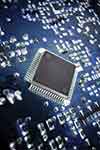What is an Integrated Circuit?
 Integrated circuits are complex devices made up of hundreds of millions of transistors, resistors, capacitors, and other components. Compared to printed circuit boards, which have a single, continuous surface, ICs are constructed on a stacked, multi-layer device. A computer-aided drafting machine prepares the design, which is then converted into a mask that is opaque in some areas and transparent in others. The mask contains images of hundreds or thousands of ICs.
Integrated circuits are complex devices made up of hundreds of millions of transistors, resistors, capacitors, and other components. Compared to printed circuit boards, which have a single, continuous surface, ICs are constructed on a stacked, multi-layer device. A computer-aided drafting machine prepares the design, which is then converted into a mask that is opaque in some areas and transparent in others. The mask contains images of hundreds or thousands of ICs.
Get Your Quote FAST! Or, Buy Online and Start Researching Today!
What are Intgrated Circuits (ICs) Made Of?
Integrated circuits are made up of semiconductors that are made up of metal, silicon, and other materials. Unlike traditional transistors, which are used to convert voltages into currents, they can also serve as switches in digital circuits. They can also help stabilize the electrical signal by allowing or limiting a certain amount of voltage. The most important component of an integrated electronic circuit is the microprocessor. The microprocessor can perform calculations and follow logic, and can serve as a computer's operating system.
The process of making an ICs involves a set of intricate parts that are connected together. Those components are known as dies, and they are small enough to fit on a small chip. These chips are also very delicate, so they are often cast into a flat block made of ceramic or plastic. This solid block is used to prevent the chip from overheating or melting. In most cases, the chip is between one square mm and 200 square mm.
How are Grids Used for Integrated Circuit Design?
Integrated Circuit (IC) layout, uses a grid-based structure to ensure that the circuit is properly designed. Grids provide an efficient way to make changes to the circuit quickly and easily. The layout must have a specific topology and should conform to the grid. The smallest grid size possible is 8x8. Another advantage of using a grid-based structure is that it helps to create an optimal pattern transfer effect, which is essential for a design.
What are the Steps for Integrated Circuit Design?
A design object is a physical layout in the design environment. The only object with enough information about its intended topology is its physical layout. Corrections to this topology should be evaluated electrically before proceeding. After completing this exercise, you can move on to the next step, which is IC layout design. But first, you need to understand the grid and its theory. There are plenty of books on this topic, and you can find one that will teach you the basics.
What are the Benefits of Integrated Circuit Grid-Based Design?
The benefits of using a grid-based approach in IC layout design include an increased number of advantages over traditional methods. As long as it can be produced reliably, this new design component can be incorporated into the existing design flow. Nevertheless, it is important to note that the grid-based approach does not replace other design methodologies, so it is important to consider the new requirements first. The layout must be large enough to address the areas of influence imposed by the process. The area factor translates to more products per wafer and a lower price.
A grid-based design can be a great benefit to the designer, who can use the same design to create multiple designs and use a variety of layout techniques to create one. The grid-based approach enables the designer to create a consistent, pleasing user experience across a range of devices. When choosing design elements, it is also important to choose those that are compatible with the user's eye tendencies. In this way, the user can view the design on any screen, no matter how small or large it is.
A grid-based approach can be advantageous to the design of the layout. It is an ideal way to ensure that the topography of an IC can be easily reproduced. It is a good way to avoid any unnecessary complications. Its biggest advantage is that it enables the designer to focus on the content of the circuit rather than on the layout. However, a grid-based design is often easier to implement.
Grid-based design enables designers to use a broader range of IC layout tools. It is crucial to understand the engineering implications of a grid-based system. It allows the designer to easily adjust the sensitivity of each feature to improve the design. A design can be scaled to multiple dimensions without affecting the function of the device. In addition, it allows the designer to optimize the layout throughput of their designs.
What Factors Affect Integrated Circuit Layer Design?
When designing IC layouts, it is important to consider a variety of different factors, including process variations. A good example of this is the manufacturability object. It is a physical object that has sufficient information about the intended topology. If a correction is required, it must be evaluated electrically. This means that an effective grid should be a good fit for the device.
When designing IC layouts, it is important to consider the varying process requirements. The layouts must be large enough to account for these varying demands. The larger the layout, the larger the area it needs to be to address pattern transfer effects. Ultimately, this will affect the cost of the ICs. When a layout is too complicated, it may not be a good solution.
